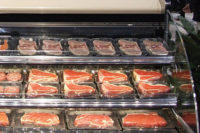One important but often-overlooked piece of equipment in the a/c system is the air filter, which protects the evaporator from dirt and lint. This article will explore how a dirty air filter can restrict airflow over the evaporator and cause very serious and expensive system problems.
POOR COOLING COMPLAINT
Say a homeowner is complaining of poor cooling in his residence. Another complaint is a reduced airflow coming from the registers in the house. The air conditioner is a 3-ton (36,000-Btuh), HCFC-22, split-type system with the A coil in the plenum of the furnace located in the basement (Figure 1).In this case the condensing unit is located on the east end of the house, a 1,500-square-foot ranch located in mid-Michigan. During an unseasonably hot summer, indoor temperatures reached 80°F; they rose steadily during the last two weeks. Indoor humidity also has been high.

Figure 1. A coil in plenum of furnace.
The compressor is sweating heavily from top to bottom. The crankcase area is extremely cold to the touch. The compressor is suffering from floodback at some point during its run cycle. Floodback is liquid refrigerant entering the crankcase of the compressor during the running cycle.
The technician installs a temperature probe on the suction line, about 6 inches from where it enters the compressor. The temperature reads 27°. The technician then subtracts the saturated evaporating temperature of 26° from the compressor inlet temperature 27° and finds out that there is only 1° of compressor superheat. (See Equation 1).
This reinforces that a floodback problem is occurring at some time during the running cycle. Floodback can ruin a compressor by diluting its oil with liquid refrigerant. This has a tendency to ruin the lubricity of the oil and score bearing surfaces in the compressor. Floodback also causes oil foaming that can cause oil to be pumped out the discharge valve and into the system. Discharge valve damage can also occur from the oil foam- and refrigerant-rich mixture.

EQUATION 1.
The technician checks the air filter in the return air cabinet before the evaporator or A coil. The filter is completely filled with dust and lint. However, even with the air filter pulled, there still is a restricted airflow problem and the fan motor continues to pull low current. The technician shuts off power to the unit and removes the plenum. The A coil is almost completely covered with ice and frost.
The technician melts the iced coil with a large-wattage blow dryer. After installing a new air filter, the technician starts the heat pump. The proper airflow has been established, the suction pressure is normal at 70 psig, and the fan motor is drawing about 7 amps.
The technician explains to the homeowner that a dirty air filter has caused a restricted airflow to the A coil evaporator. He explains the importance of keeping the air filter clean. This restriction in the airflow has caused a low suction pressure because of a reduced heat load entering the evaporator coil. This caused a slower vaporization rate of refrigerant in the evaporator.
The low suction pressure made the refrigerant flowing through the evaporator below freezing (26°F). This finally froze the evaporator coil solid with ice. The restricted airflow also unloaded the fan motor causing it to draw low amperage.
Once the evaporator coil froze solid, the refrigerant saw very little heat and humidity load. This caused a low vaporization rate and some of the liquid refrigerant (R-22) trickled down the suction line to the compressor’s crankcase causing floodback. This is why there was only 1° of compressor superheat and the crankcase area was cold to the touch.
The low heat and humidity load on the evaporator also caused the head pressure to be low. This happened because if there was very low heat being absorbed in the evaporator section, there will be hardly any heat rejected into the condenser section of the system. This will keep condensing (head) pressures down.
Many technicians will try to add refrigerant when they experience low suction and low head pressures simultaneously. This is not always the answer. It is true that an undercharge of refrigerant will cause low head and suction pressures, but that is not the only thing that will cause both pressures to be low.
In this case, something as simple as a dirty air filter was the culprit in freezing the coil and causing low head and suction pressures. The low airflow was the major clue, and it would not have been noticed if the technician did not talk with the homeowner before troubleshooting.
Publication date:04/02/2007





